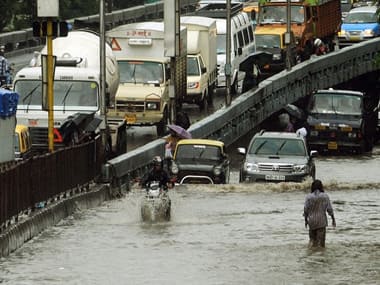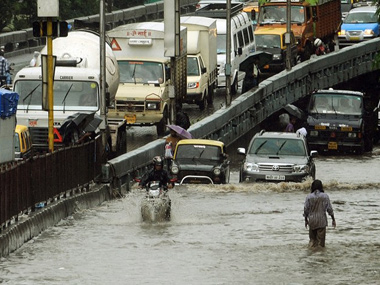Does Mumbai need the kind of rainfall it gets every monsoon? Hovering around an annual 2,146.6 mm for the Island City, and 2,457 mm for the suburbs, as an average and normal, it’s more than what the city can cope with. One, in years of general scarcity of water, which seems to loom this year too due to the late monsoon, the glut in the metropolis stands out in contrast with the virtual absence of any precipitation in the catchment areas of lakes that provide drinking water. Two, it exposes the city government’s hardened ways of not preparing for the rains despite the proven ability of the monsoon to expose its sheer administrative incapacity. It won’t change, so the rains shouldn’t play spoilsport. If it doesn’t rain there, the city has to dread the prospect of taps going dry in the months ahead. Only 93 days of supply is currently available in the several lakes – Tansa, Modaksagar, Bhatsa, Vihar, Tulsi, Upper Vaitarna. The Times of India has a chart. [caption id=“attachment_1638015” align=“alignleft” width=“380”]  Representational Image. AFP[/caption] One supposes we should rather it rained there instead of here. But generally the chatter in drawing rooms, the reportage in the media – print and television – seems to focus on rains in the city than elsewhere. As if rains here make any difference. Of course, if it did, it is limited to the population feeling cooler than in the sweltering humidity of a coastal city. But that means little to the balance of storage and supply of drinking water to the 1.24 cr population who do not get equitably distributed water. Officially, the 5.93 million residents of the city who do not live in slums get 200 litres per day per person. Those in the slums, who account for much more than the non-slum population, or 6.5 million in number, get exactly half. But that is on paper, an average. Huge swathes go without piped supply. Even this is in jeopardy this year. Fickle nature being what it is, it is possible the precipitation shifts to south of Mumbai on the mainland and blesses the city with the usual but skewed supply till the next monsoon arrives. Or else, it could only be a harrowing time. There are a whole lot of negatives the city suffers on account of copious rainfall. Though the highest ever precipitation of 944 mm in 24 hours of July 26, 2005 was an exception that wrought havoc on the city, the details remain ingrained in every mind. So scared are the residents of things coming to a halt that school bus operators have decided not to ferry the kids, also because of the craters the civic body underplays as potholes. What happens when it rains? Here is a small list: * Roads get waterlogged and traffic comes to a standstill. * Railway tracks are submerged and train services, a much more valuable service than road transportation, grind to a halt and millions get stranded. The signalling system too goes for a toss. * A single good shower causes potholes to emerge, though the roads were supposed to have been repaired only weeks before in the annual ritual of hastened attention to beat the monsoon. * It exposes the poor governance of all the city agencies – MMRDA, the Central and the Western Railways, Municipal Corporation of Greater Mumbai – who sell the fiction every year that they are better placed than in the previous year to cope. The first rain halted trains services and stranded people in the stuffy coaches for hours. * It exposes the contractors too who claim they had done the work on potholes only to find more of them within days of a first shower – like the Dindoshi Flyover whose repair had let to snarls and post-repair, continued with snarls because the potholes resurfaced. * This year, however, the civic body and its contractor buddies got a clear 45 days extra time to fix the roads. It claims only 784 potholes are yet to be repaired, as of yesterday. This after a claim of having mended 2,730 potholes, as Loksatta, a Marathi newspaper, reported today. * It exposes the contractors who claimed to have done the cleaning of the storm water drains but obviously didn’t. It is clear by the way they choke quickly. Their belief, it would appear, is rain washes away the muck quicker and more efficiently than they themselves claim to have done. This list can continue, by adding how taxis and autorickshaws scalp passengers stranded due to the lifeline – the railway commuter network -snuffing itself out now and then. There are neither questions asked by the authorities nor any solutions ever found. Every time the city stops in its tracks, the merchants’ guilds are quick to offer numbers as losses suffered by business not being done but unfortunately they relate only to days of political street actions we call bandhs. They too seem to be resigned that it is the part of force majeure – an act of God so to be taken in stride. And that ascription to an act of God is the undoing of the city which does not demand that lessons be learnt from the annual disasters brought upon by the rains, even if the rainfall has been within the average. That is why, instead of the natural thing to do, we live it to the play of nature. That is one good reason why this city does not deserve the kind of rainfall it gets. Instead, so it can be business as usual, it ought to rain elsewhere to fill the reservoirs that supply water. There is no other way of overcoming the administrative ills. Just change the factors that expose the inadequacies and believe all is well. It only makes everyone miserable except those who should ensure the city system faces, not braves, the rains and supinely accepts the misery brought in the monsoon’s wake.
There is no other way of overcoming the administrative ills. Just change the factors that expose the inadequacies and believe all is well.
Advertisement
End of Article
Written by Mahesh Vijapurkar
Mahesh Vijapurkar likes to take a worm’s eye-view of issues – that is, from the common man’s perspective. He was a journalist with The Indian Express and then The Hindu and now potters around with human development and urban issues. see more


)
)
)
)
)
)
)
)
)



